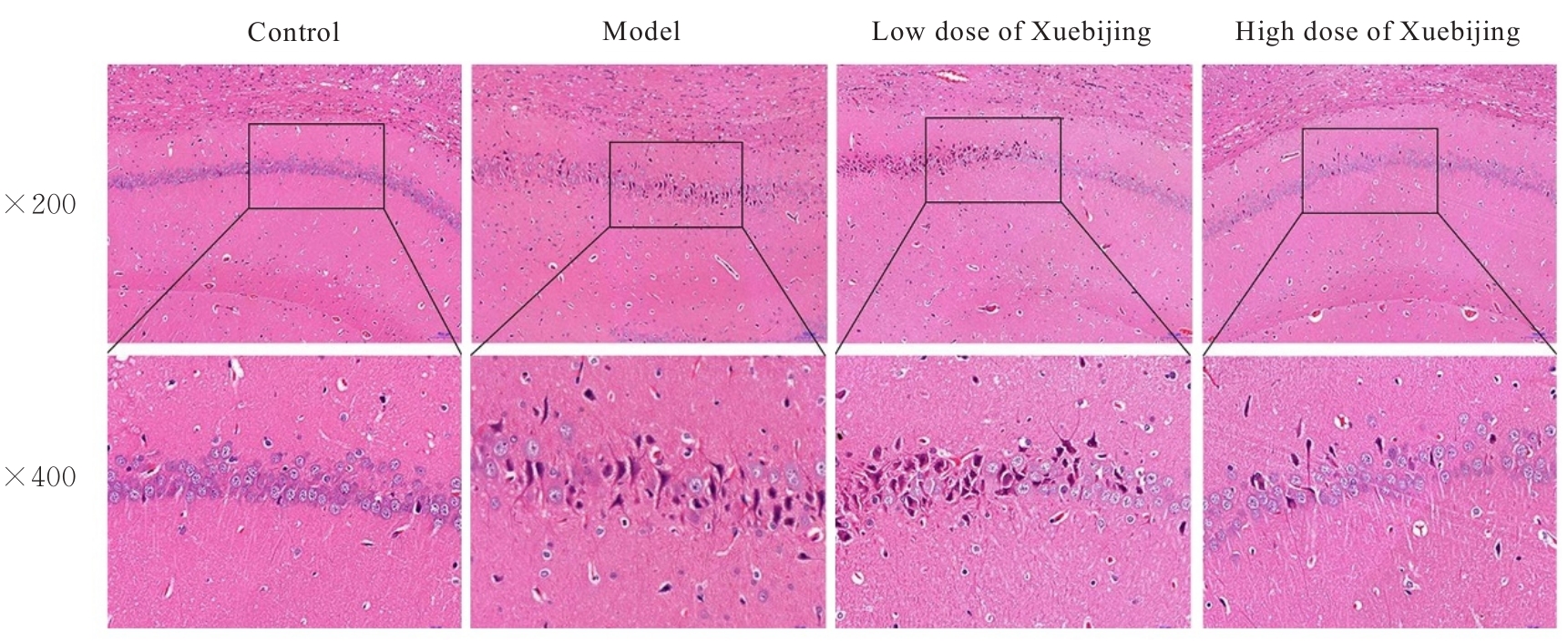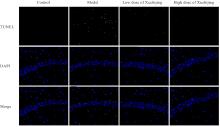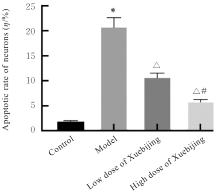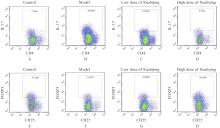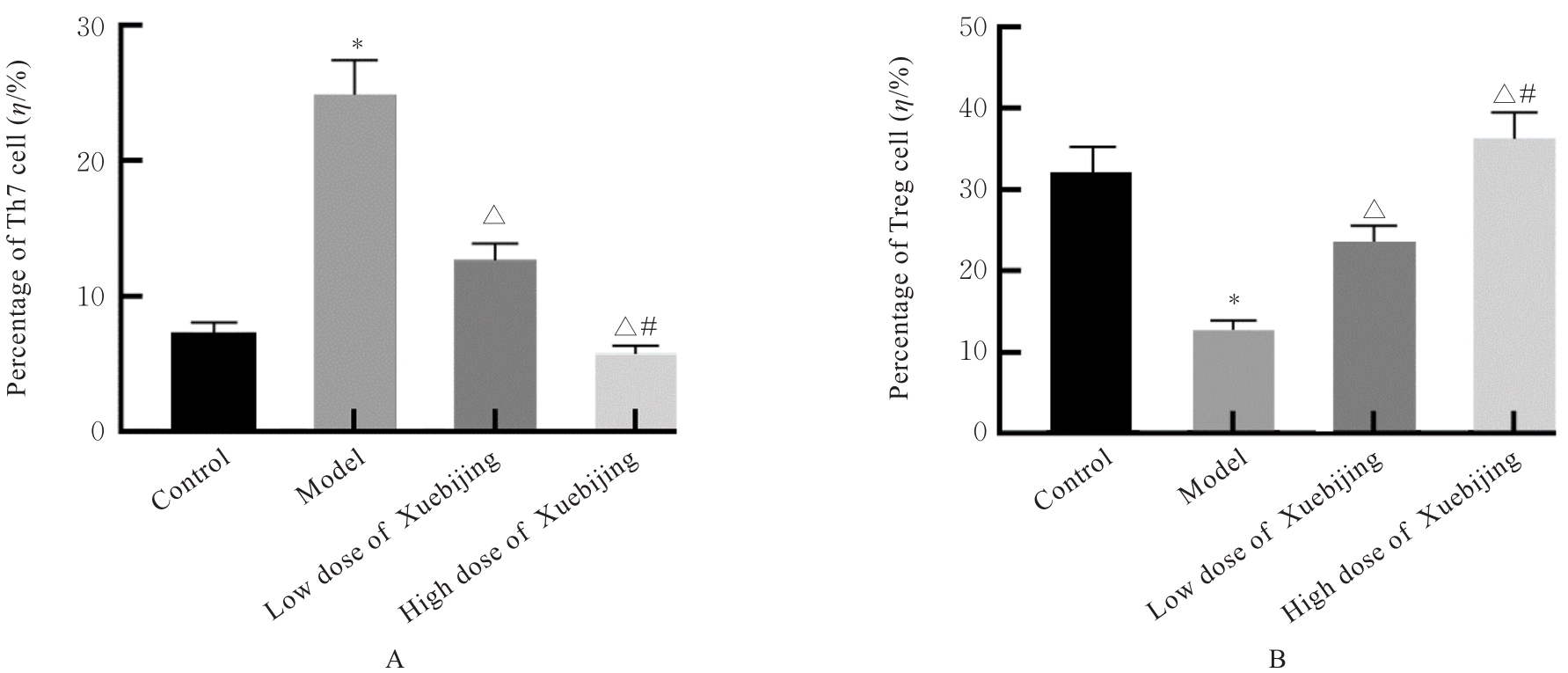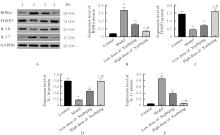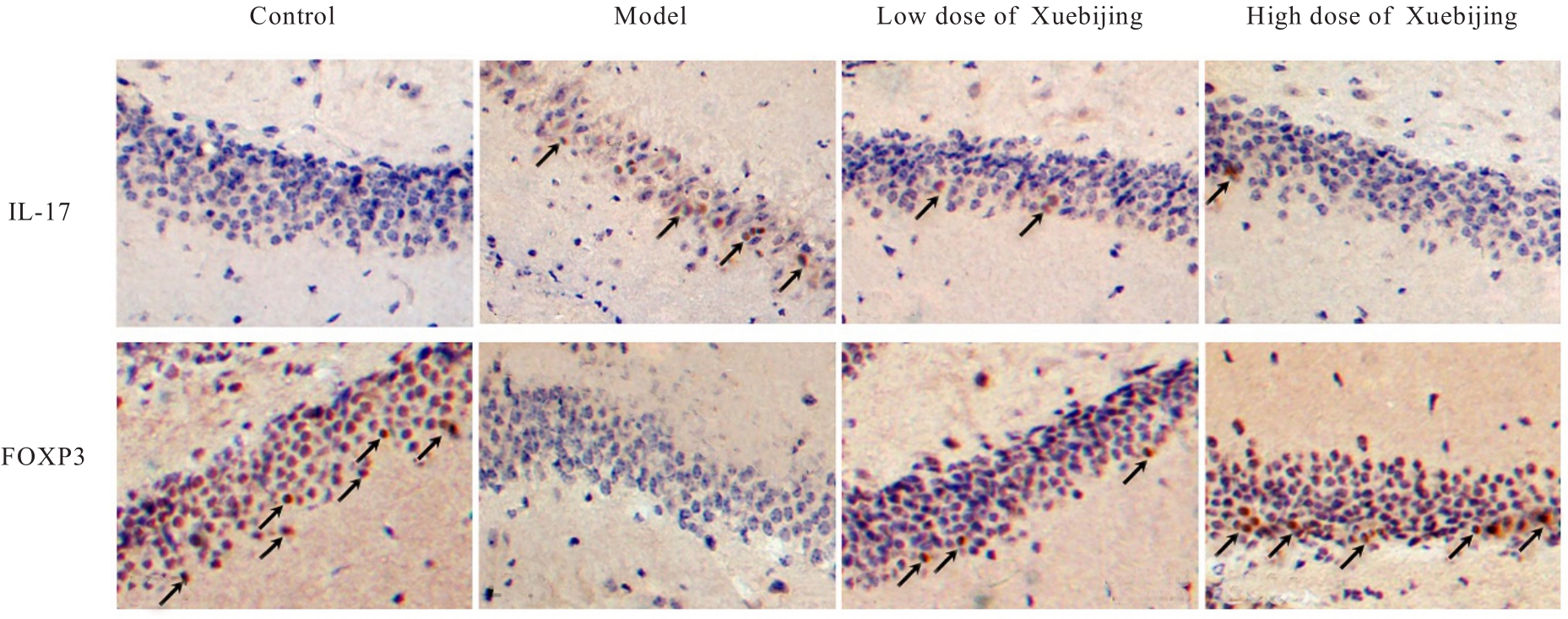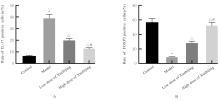吉林大学学报(医学版) ›› 2024, Vol. 50 ›› Issue (3): 697-707.doi: 10.13481/j.1671-587X.20240314
• 基础研究 • 上一篇
血必净对抗NMDA受体脑炎模型小鼠脑组织损伤及脑脊液中Th17/Treg免疫失衡的改善作用
- 海南医学院第二附属医院神经内科,海南 海口 570311
Improvement effect of Xuebijing on brain tissue injury and Th17/Treg immune imbalance in cerebrospinal fluid in NMDA receptor encephalitis model mice
Lin CHEN,Limin YAN,Huaijie XING,Min CHEN,Xiaoyan LI,Chaosheng ZENG( )
)
- Department of Neurology,Second Affiliated Hospital,Hainan Medical College,Haikou 570311,China
摘要:
目的 探讨血必净对抗N-甲基-D-天门冬氨酸(NMDA)受体脑炎模型小鼠脑组织损伤及脑脊液(CSF)中辅助性T淋巴细胞17(Th17)/调节性T淋巴细胞(Treg)免疫失衡的影响,阐明其治疗作用。 方法 60只健康雄性C57BL/6J小鼠随机分为对照组、模型组、低剂量血必净组和高剂量血必净组,每组15只。除对照组外,其余3组小鼠均给予抗原注射与免疫刺激结合法建立抗NMDA受体脑炎模型,低和高剂量血必净组小鼠分别给予腹腔注射5和10 mL·kg-1血必净注射液。采用HE染色观察各组小鼠脑组织病理形态表现,TUNEL法检测各组小鼠脑组织海马CA1区神经元凋亡率,酶联免疫吸附试验(ELISA)法检测各组小鼠血清中白细胞介素(IL)-6、IL-10、IL-17和转化生长因子β(TGF-β)水平,流式细胞术检测各组小鼠CSF中Th17和Treg细胞百分率,Western blotting法检测各组小鼠脑组织中维甲酸相关核孤儿受体(RORγt)、叉头状转录因子3(Foxp3)、IL-10和 IL-17 蛋白表达水平, 免疫组织化学染色法检测各组小鼠脑组织中 IL-17 和 Foxp3 阳性细胞率。 结果 HE染色,对照组小鼠脑组织海马 CA1 区结构清晰,未见明显病变;与对照组比较,模型组小鼠脑组织海马CA1区部分锥体细胞呈三角形固缩浓染,顶树突拉长,少数神经细胞脱失,组织稀疏;与模型组比较,低和高剂量血必净组小鼠脑组织海马CA1区细胞损伤减小,形态恢复正常,排列较为整齐,且高剂量血必净组小鼠脑组织海马CA1区损伤的改善情况更明显。TUNEL法,与对照组比较,模型组小鼠脑组织海马CA1区神经元凋亡率明显升高(P<0.05);与模型组比较,低和高剂量血必净组小鼠脑组织海马CA1区神经元凋亡率明显降低(P<0.05);与低剂量血必净组比较,高剂量血必净组小鼠脑组织海马CA1区神经元凋亡率明显降低(P<0.05)。ELISA法,与对照组比较,模型组小鼠血清中IL-6和IL-17水平明显升高(P<0.05),IL-10和TGF-β水平明显降低(P<0.05);与模型组比较,低和高剂量血必净组小鼠血清中IL-6和IL-17水平明显降低(P<0.05),IL-10和TGF-β水平明显升高(P<0.05);与低剂量血必净组比较,高剂量血必净组小鼠血清中IL-6和IL-17水平明显降低(P<0.05),IL-10和TGF-β水平明显升高(P<0.05)。流式细胞术,与对照组比较,模型组小鼠CSF中CD4+IL-17A+Th17细胞百分率明显升高(P<0.05),CD25+Foxp3+Treg细胞百分率明显降低(P<0.05);与模型组比较,低和高剂量血必净组小鼠CSF中CD4+IL-17A+Th17细胞百分率明显降低(P<0.05),CD25+Foxp3+Treg细胞百分率明显升高(P<0.05);与低剂量血必净组比较,高剂量血必净组小鼠CSF中CD4+IL-17A+Th17细胞百分率明显降低(P<0.05),CD25+Foxp3+Treg细胞百分率明显升高(P<0.05)。Western blotting法,与对照组比较,模型组小鼠脑组织中RORγt和IL-17蛋白表达水平明显升高(P<0.05),Foxp3和IL-10蛋白表达水平明显降低(P<0.05);与模型组比较,低和高剂量血必净组小鼠脑组织中RORγt及IL-17蛋白表达水平明显降低(P<0.05),Foxp3和IL-10蛋白表达水平明显升高(P<0.05);与低剂量血必净组比较,高剂量血必净组小鼠脑组织中RORγt和IL-17蛋白表达水平明显降低(P<0.05),Foxp3和IL-10蛋白表达水平明显升高(P<0.05)。免疫组织化学染色法,与对照组比较,模型组小鼠脑组织中IL-17阳性细胞率明显升高(P<0.05),Foxp3阳性细胞率明显降低(P<0.05);与模型组比较,低和高剂量血必净组小鼠脑组织中IL-17阳性细胞率明显降低(P<0.05),Foxp3阳性细胞率明显升高(P<0.05);与低剂量血必净组比较,高剂量血必净组小鼠脑组织中IL-17阳性细胞率明显降低(P<0.05),Foxp3阳性细胞率明显升高(P<0.05)。 结论 血必净能够有效改善抗NMDA受体脑炎小鼠脑组织损伤,调控细胞因子水平,干预抗NMDA受体脑炎小鼠Th17/Treg免疫失衡现象。
中图分类号:
- R512.3

